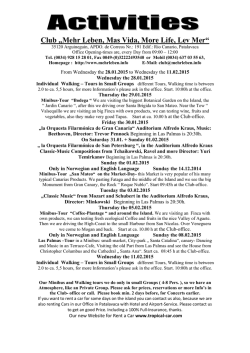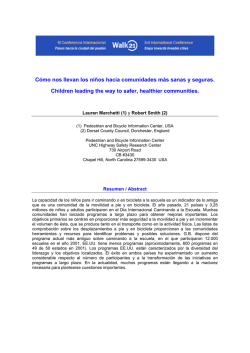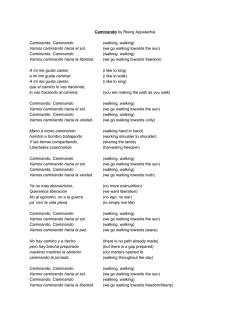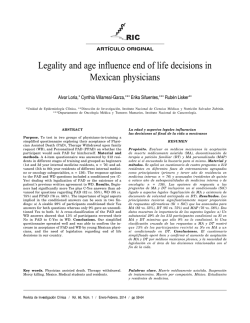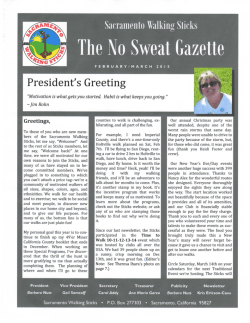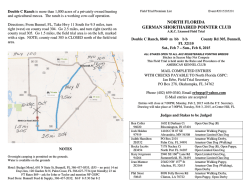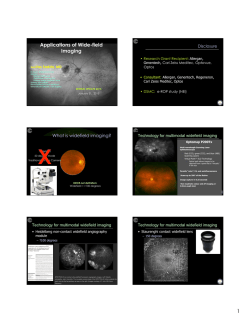
Probekapitel zu: „Sporttherapie internistischer Krankheitsbilder“
Exercise training in Peripheral Arterial Disease 155. Available at URL: http://www.ismj.com International SportMed Journal, Vol.12 No.4, 2011, pp. 150- ISMJ International SportMed Journal FIMS Position Statement 2011 Exercise training in Peripheral Arterial Disease *Professor Arno Schmidt-Trucksäss, MD, MA Division Sports and Exercise Medicine, Institute of Exercise and Health Sciences, Basel, Switzerland *Corresponding author. Address for correspondence at the end of text. Abstract Peripheral arterial occlusive disease (PAD) is characterized by a decreased oxygen supply of the lower limbs during physical activity associated with exercise-induced pain or other symptoms like muscle weakness. The basis of therapy is the treatment of atherosclerotic risk factors. Physical activity like walking has been shown to improve pain free and maximal walking distance by more than 100%. Recommendations for training are based on treadmill tests or a free walking test prior to training start. Reassessment is recommended in order to adapt training intensity and volume. Exercise training has to be prescribed systematically. Structured training programs are more efficient than unstructured. Keywords: peripheral arterial occlusive disease, exercise *Professor Arno Schmidt-Trucksäss. MD, MA Professor Schmidt-Trucksäss Deputy Director Institute of Exercise and Health Sciences Basel, Switzerland . He is Head of the Department Sports Medicine, University Hospital Freiburg, Germany. He is also Professor and Chair of Sports Medicine and the Institute of Exercise and Health Sciences, Medical Faculty, University Basel, Switzerland. Introduction Peripheral arterial occlusive disease (PAD) is a chronic, progressive atherosclerotic process. In this disease, the blood flow to the lower limbs is reduced which may lead to an imbalance between oxygen supply and demand during physical activity causing intermittent claudication. Typical symptoms are cramps, Table 1: Fontaine stages I to IV in PAD I II IIa IIb III IV 150 pain, weakness and feeling of tension in the affected muscles, predominantly in the calves, but also in the sole, upper leg and sometimes the gluteal area. Usually symptoms occur during fast walking and disappear when at rest. According to the symptoms, PAD can be classified into four stages (Table 1). Symptom free Intermittent claudication Pain free walking distance >200 m Pain free walking distance <200 m Pain at rest Necrosis (gangrene) Official Journal of FIMS (International Federation of Sports Medicine) Exercise training in Peripheral Arterial Disease 155. Available at URL: http://www.ismj.com International SportMed Journal, Vol.12 No.4, 2011, pp. 150- Epidemiology Diagnosis The prevalence of PAD, as defined on the ankle brachial index (ABI) with a value < 0.9, amputation or peripheral revascularisation, is 1 18% in persons over 65 years of age . There is an 11% increase in PAD incidence between 60 to 65 years of age, followed by a sharper increase (39%) up to 85 years and older. Diabetic patients between 60 and 69 years of age have a threefold higher incidence of PAD than non-diabetics (men 16.3‰ vs. 5.4‰, women 13.1‰ vs. 3.1‰). PAD occurs 10 years earlier in type 2 diabetic patients than in non-diabetics which may be due to the increased long- term exposure to atherosclerotic risk factors, leading to a faster progression of atherosclerotic vascular 2 changes . Clinical examination is the most important diagnostic tool for recognising PAD. Additional examinations of the peripheral arterial blood flow and pressure with ultrasound Doppler techniques help in precisely localising stenosis and quantifying its severity. Among diagnostic tools, the estimation of the ankle-brachial index (blood pressure ratio between ankle and arm) is a simple, reliable method for identifying individuals that are at increased risk for cardiovascular events. The ankle-brachial index (ABI) is highly specific (88%-93%) in the prediction of future cardiovascular events. However, a high value does not exclude significant PAD because of its low sensitivity. From a clinical point of view measurement of ABI is a valuable screening method in symptom -free persons older than 70 years or in persons 50 to 69 years of age with one or more atherogenic risk factors. According to the same authors, an ABI of 0.91-1.3 is considered normal, a value of 0.41- 0.90 indicates a lightto moderate PA,D usually with prevalent claudication, and a ≤0.40 value indicates a critical limb ischemia, usually with pain at rest, or tissue lesion. Incompressible arteries have values >1.3 and are typically found in diabetic 6 patients (10%) caused by media calcinosis . Pathophysiology PAD patients suffer from different impairments in daily life. Some of them can only walk a few 3 hundred meters without experiencing pain . Thus they are confined to their homes, becoming more and more isolated and losing their social contacts. Physical inactivity further negatively impacts the atherosclerotic risk factor profile. Physical inactivity itself is associated with a reduced blood flow and shear stress in the arteries of the working muscles. This causes a reduced production of nitric oxide, the most potent anti-atherosclerotic mediator in endothelial cells. Atherosclerotic procession is thought to proceed faster in the presence of other risk factors in patients with low local and 4 systemic nitric oxide concentrations . The arteries of immobilised limbs reduce their diameter and elasticity by about a third. In the absence of physical activity, patients with claudication do not elicit the local acidosis needed for the affected limb to develop collateral vessels. 5 The most prevalent risk factors in PAD , besides physical inactivity, are hypertension (78.8 %), smoking (58.7 %), dyslipoproteinemia (57.2 %) and diabetes mellitus type 2 (36.6 %). Smokers are at highest risk to develop PAD (9.3 fold), followed by type 2 diabetics (4.4 fold), and patients with hypertension (3.3 fold) and dyslipoproteinemia (2.7 fold) respectively. 151 Since not only peripheral arteries are affected by the ongoing atherosclerotic process in PAD patients, it is necessary to check other typical sites for atherosclerotic manifestations. There is a high prevalence of atherosclerosis in the carotid tree (ultrasound examination advisable). Moreover, coronary perfusion may be impaired due to atherosclerotic coronary 7 lesions . Thus cardiovascular examination, including resting and exercise ECG, is recommended before starting an exercise 5 programme . A maximal exercise tolerance test in order to exclude hemodynamically impaired coronary artery disease might not be possible as symptoms caused by insufficient peripheral perfusion sometimes limit exercise capacity. The arm or rowing ergometer may be applied under these circumstances. Therapy The therapeutic aim in PAD is to improve functional capacity and quality of life by means of conservative and/or interventional therapy. Basic therapy includes a reduction in artherosclerotic risk factors by lifestyle modification (in particular, physical activity, smoking cessation and diet modification) with Official Journal of FIMS (International Federation of Sports Medicine) Exercise training in Peripheral Arterial Disease 155. Available at URL: http://www.ismj.com or without medication, and the use of vasoactive and antithrombotic drugs (Table 2). The focus and most difficult part of the therapy is the reduction of classical risk factors. The higher the risk factor burden, the stricter the therapy should be. Smoking cessation is an 6 essential part of risk factor reduction therapy . However, the results of anti-smoking programmes are poor and the percentage of those who relapse is very high. Only around International SportMed Journal, Vol.12 No.4, 2011, pp. 150- 15% of smokers are able to quit smoking in the long term. Behaviour modification associated with smoking and nicotine supplementation with skin plasters should be applied under professional guidance. In addition, exercise 8 training helps to maintain smoking cessation as ex-smokers may feel an acute and chronic improvement in their exercise capacity. Table 2: List of drugs used in PAD Drug Cilostazol Function Vasodilation, inhibitor of thrombocyte function, improves walking distance Naftidrofuryl Improves muscle metabolism, reduces erythrocyte and platelet aggregation, improves claudication symptoms Aspirin Statins Reduction of cardiovascular events Reduces cholesterol, improves endothelial function, may improve walking distance 10,11 Details on medical treatment are given in the ACC/AHA 2005 Guidelines for the Management of Patients With Peripheral 5 Arterial Disease and Inter-Society Consensus for the Management of Peripheral Arterial 6 Disease (TASC II) . . The CLEVER trial (Claudication: one year Exercise versus Endoluminal Revascularisation) aims to compare medical therapy, stenting, and exercise training in patients with claudication and aortoiliac 12 obstructive disease . Statins and aspirin may improve treadmill walking performance but are not a substitute for walking exercise because of little effect 9 without actual exercise training . However, both drugs are part of standard therapy. Cilostazol has been shown to improve treadmill 5 walking performance by 40% to 60% . Exercise training The interventional therapy includes percutaneous transluminal angioplasty (PTA), stent implantation or atherectomy and bypass surgery. Interventional therapy is usually applied when conservative therapeutic methods are not successful, especially if amputation becomes imminent. Ileofemoral revascularisation yields the best clinical outcome in the long term prognosis, and results with this type of treatment are better than an intervention of the femoro popliteal stenosis. Surgical reconstruction is the gold standard for stages III/IV. Amputation of the lower limb can be applied as the final therapeutic option. The comparison of PTA with exercise training elicits better short -term results but there is no difference or even lower walking distance after 152 The clinical benefit of endurance exercise training in PAD therapy is an increase in exercise tolerance. This is mediated through an increase in shear stress caused by the augmented blood flow to the stenotic arteries. Local ischemia induced by repetitive exercise stimulates vascular compensation by pre13 existing collateral circulation . Exercise training also improves the arteriovenous oxygen difference and movement economy, which, in turn, contributes to better 14 exercise tolerance . Endurance exercise also decreases blood viscosity and positively enhances hemorheologic properties. The average walking speed of PAD patients is around 2.5 – 3.0 km/h. The aim of endurance exercise training should be to increase walking speed up to 4.5 – 5.0 km/h, which constitutes the habitual walking speed of a healthy person. It has been demonstrated that endurance exercise training over 12 weeks increased maximal treadmill walking time by 123% and 15 pain free walking time by 165% . Even current Official Journal of FIMS (International Federation of Sports Medicine) Exercise training in Peripheral Arterial Disease 155. Available at URL: http://www.ismj.com smokers doubled their pain free (+119%) and maximal walking distances (+82%), which is a strong argument for exercise training even in the presence of the most prevalent risk 16 factor . The benefits associated with increased walking distance directly transfer into daily activities and improve quality of life. It is important to assess pain free and maximal walking distance prior to starting an exercise training program. This can be done on a treadmill and or in a field test. An exercise test on the treadmill is done at constant load intensity (velocity of 3.0 km/h and an incline of 12%). The decisive parameter is the “pain free” walking time or distance (until first onset of pain). „Low“ is a walking distance < 100 m, moderate between 100 – 300 m. Over 300 a „Walking-through“-phenomenon might happen. An ankle pressure < 50 mmHg at test cessation due to claudication confirms PAD, which limits exercise performance. An ankle pressure > 50 mmHg at test cessation indicates a pseudoclaudication due to other reasons like heart failure or chronic obstructive lung disease. The pain free walking distance can also be assessed using a simple walking test. At a walking speed of 100 m/min (6 km/h), the patient has to repeat the test three times with 5 min rest between each walking test. The test has to be carried out on a plain surface. The pain free walking distance forms the basis for exercise prescription. Examination and palpitation of the ankles and the spine may be necessary prior to starting an exercise training program, as arthritis or deformities may mimic claudication or be the possible reason for pain during walking. Training programs usually instruct patients to walk until maximal pain tolerance is reached, rest until pain subsides, and then resume 17 walking. On this basis a metaanalysis reported the greatest improvement in walking distances with an exercise program lasting > 30 min in duration per exercise session, a frequency ≥ 3 sessions per week, and program duration > 6 months. Distance walked increased by 179% until the onset of claudication pain and distance walked increased by 122% until maximal claudication pain endurable was reached. Low and high intensity training seem to have the same efficacy in improving markers of functional independence in PAD patients limited by 18 intermittent claudication . An alternative to that regimen may be a pain-free walking 19 training eliciting an increase of 104% or 20 138% in walking distance after 6 or 12 153 International SportMed Journal, Vol.12 No.4, 2011, pp. 150- weeks of training, respectively. So far it is not possible to decide which type of endurance training is the better with respect to the demands of daily life; pain-free training might show a better adherence of PAD patients to 21 the prescribed exercise program . Strength training deems not be an equivalent alternative to endurance training, because it has only a marginal effect on walking distance in six minute walk test (plus 12.4 m) after a 6 months training period. However, stair climbing was significantly improved indicating at least a 22 small benefit for daily living . Treadmill walking programs can be based on previous test results. For example, 300 m pain free walking distance at the velocity of 3 km/h and 12 % incline is equivalent to 5 km/h at 10 % or 7 km/h at 8 % incline. Exercise training should be held at 80 % of this intensity (e.g. 6 % at 6 km/h or 8 % at 4 km/h). The patient should rest for 3-5 min at onset of pain caused by claudication. Then training should be continued in the same sequence until 60 min in duration is reached. If the patient does not experience any claudication pain within the first 10 min, treadmill incline can be increased by 1.5 % until a 10 % incline is reached. An incline above 10 % is not tolerated very well by most patients because of complains of the ankle joints. As an alternative, the treadmill speed can be increased incrementally by 0.5 km/h until a maximum of 6 km/h is reached. It is very important to continue exercise training after successful revascularization. Results are much better compared to revascularization alone. Further, supervised training has a much better response rate than home-based training. 68.4 % of patients enrolled in a supervised training program increased their walking distance by >100%, while only 38.1% of patients using a home based program were 23 able to achieve this result . The difference between supervised and non-supervised groups amounts to approximately 150 meters increase in walking distance in favour of the supervised group which has been shown in a Cochrane review of 8 randomized controlled 20 trials . The mean baseline pain free walking distance was 200 m and maximal walking distance was around 300 m. Thus 150 meters more clearly reflects a benefit in daily live. These are strong arguments for employing professional expertise in the initial training phase. Secondary aims are gait control, improved flexibility of the lower limbs and strengthening of the trunk musculature. Moreover, training in a group increases patient Official Journal of FIMS (International Federation of Sports Medicine) Exercise training in Peripheral Arterial Disease 155. Available at URL: http://www.ismj.com motivation, compliance, and adherence to the 20 exercise training program . The positive results of walking programs in PAD are shadowed by the fact that only 30% of all patients are able to participate in exercise training programs. Frequent neurological and orthopaedic problems make participation impossible. A possible alternative to walking training seems to be exercise training with the upper extremities. Thus, arm ergometer exercise resulted in a prolongation of pain free and maximal walking distance by 51% and 24 29% after a 6 months training period . Another randomized controlled trial with arm ergometric exercise versus treadmill walking improved pain free walking distance by 82% and 54% and maximal walking distance by 53% and 25 69%, respectively . These studies are promising to show an alternative training regimen for PAD patients with walking disabilities. An absolute contraindication for walking training in PAD patients is claudication pain at rest with an ankle pressure of < 50 mmHg. Acknowledgement The author thanks Mrs M Jehn for her assistance in the preparation of this manuscript. Address for correspondence: Professor Arno Schmidt-Trucksäss, Division Sports and Exercise Medicine, Institute of Exercise and Health Sciences, St. Jakob Arena, Brüglingen 33, CH-4052 Basel, Switzerland Tel.: +41-61-377 8741 Fax: +41-61-377 8742 Email: [email protected] References 1. Diehm C, Lange S, Darius H, et al. Association of low ankle brachial index with high mortality in primary care. Eur Heart J 2006;27 (14):1743–1749. 2. Lower extremity disease among persons aged > or =40 years with and without diabetes--United States, 19992002. MMWR Morb Mortal Wkly Rep 2005;54 (45):1158–1160. 3. Hiatt WR, Regensteiner JG, Hargarten ME, et al. Benefit of exercise conditioning for patients with peripheral arterial disease. Circulation 1990;81 (2):602–609. 154 International SportMed Journal, Vol.12 No.4, 2011, pp. 150- 4. Ueno H, Kanellakis P, Agrotis A, et al. Blood flow regulates the development of vascular hypertrophy, smooth muscle cell proliferation, and endothelial cell nitric oxide synthase in hypertension. Hypertension 2000;36 (1):89–96. 5. Hirsch AT, Haskal ZJ, Hertzer NR, et al. ACC/AHA 2005 Practice Guidelines for the management of patients with peripheral arterial disease (lower extremity, renal, mesenteric, and abdominal aortic): a collaborative report from the American Association for Vascular Surgery/Society for Vascular Surgery, Society for Cardiovascular Angiography and Interventions, Society for Vascular Medicine and Biology, Society of Interventional Radiology, and the ACC/AHA Task Force on Practice Guidelines (Writing Committee to Develop Guidelines for the Management of Patients With Peripheral Arterial Disease): endorsed by the American Association of Cardiovascular and Pulmonary Rehabilitation; National Heart, Lung, and Blood Institute; Society for Vascular Nursing; TransAtlantic InterSociety Consensus; and Vascular Disease Foundation. Circulation 2006;113 (11):e463–654. 6. Norgren L, Hiatt WR, Dormandy JA, et al. Inter-Society Consensus for the Management of Peripheral Arterial Disease (TASC II). J Vasc Surg 2007;45 Suppl S:S5–67. 7. Bhatt DL, Steg PG, Ohman EM, et al. International prevalence, recognition, and treatment of cardiovascular risk factors in outpatients with atherothrombosis. JAMA 2006;295 (2):180–189. 8. Prochaska JJ, Hall SM, Humfleet G, et al. Physical activity as a strategy for maintaining tobacco abstinence:A randomized trial. Prev Med 2008;47( 2):215–220. 9. Mannarino E, Pasqualini L, Innocente S, et al. Physical training and antiplatelet treatment in stage II peripheral arterial occlusive disease: Alone or combined? Angiology 1991;42 (7):513–521. 10. Creasy TS, McMillan PJ, Fletcher EW, et al. Is percutaneous transluminal angioplasty better than exercise for claudication? Preliminary results from Official Journal of FIMS (International Federation of Sports Medicine) Exercise training in Peripheral Arterial Disease 155. Available at URL: http://www.ismj.com 11. 12. 13. 14. 15. 16. 17. 18. 155 a prospective randomised trial. Eur J Vasc Surg 1990;4 (2):135–140. Perkins JM, Collin J, Creasy TS, et al. Exercise training versus angioplasty for stable claudication. Long and medium term results of a prospective, randomised trial. Eur J Vasc Endovasc Surg 1996;11 (4):409–413. Bronas UG, Hirsch AT, Murphy T, et al. Design of the multicenter standardized supervised exercise training intervention for the claudication: exercise vs endoluminal revascularization (CLEVER) study. Vasc Med 2009;14 (4):313–321. Ziegler MA, Distasi MR, Bills RG, et al. Marvels, mysteries, and misconceptions of vascular compensation to peripheral artery occlusion. Microcirculation 2010;17 (1):3–20. Womack CJ, Sieminski DJ, Katzel LI, et al. Improved walking economy in patients with peripheral arterial occlusive disease. Med Sci Sports Exerc 1997;29 (10):1286–1290. Hiatt WR, Wolfel EE, Meier RH, et al. Superiority of treadmill walking exercise versus strength training for patients with peripheral arterial disease. Implications for the mechanism of the training response. Circulation 1994;90 (4):1866–1874. Gardner AW, Killewich LA, Montgomery PS, et al. Response to exercise rehabilitation in smoking and nonsmoking patients with intermittent claudication. J Vasc Surg 2004;39 (3):531–538. Gardner AW, Poehlman ET. Exercise rehabilitation programs for the treatment of claudication pain. A metaanalysis. JAMA 1995;274 (12):975– 980. Barak S, Stopka CB, Archer Martinez C, et al. Benefits of low-intensity pain- International SportMed Journal, Vol.12 No.4, 2011, pp. 150- 19. 20. 21. 22. 23. 24. 25. free treadmill exercise on functional capacity of individuals presenting with intermittent claudication due to peripheral arterial disease. Angiology 2009;60 (4):477–486. Gardner AW, Montgomery PS, Flinn WR, et al. The effect of exercise intensity on the response to exercise rehabilitation in patients with intermittent claudication. J Vasc Surg 2005;42(4):702–709. Bendermacher BLW, Willigendael EM, Teijink JAW, et al. Supervised exercise therapy versus non-supervised exercise therapy for intermittent claudication. Cochrane Database Syst Rev 2006;(2):CD005263. Fernandez BB Jr. A rational approach to diagnosis and treatment of intermittent claudication. Am J Med Sci 2002;323 (5):244–251. McDermott MM, Ades P, Guralnik JM, et al. Treadmill exercise and resistance training in patients with peripheral arterial disease with and without intermittent claudication: A randomized controlled trial. JAMA 2009;301 (2):165–174. Imfeld S, Singer L, Degischer S, et al. Quality of life improvement after hospital- based rehabilitation or homebased physical training in intermittent claudication. VASA 2006;35 (3):178– 184. Zwierska I, Walker RD, Choksy SA, et al. Upper- vs lower-limb aerobic exercise rehabilitation in patients with symptomatic peripheral arterial disease: a randomized controlled trial. J Vasc Surg 2005;42 (6):1122–1130. Treat-Jacobson D, Bronas UG, Leon AS. Efficacy of arm-ergometry versus treadmill exercise training to improve walking distance in patients with claudication. Vasc Med 2009;14 (3):203–213. Official Journal of FIMS (International Federation of Sports Medicine)
© Copyright 2025
